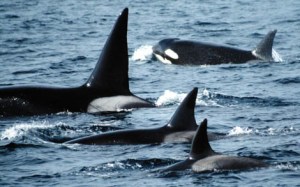GRAY WHALES OFF MONTEREY: THEIR SOUTHBOUND JOURNEY
 The first pod of Gray Whales was spotted passing Monterey Bay on December 8th by marine biologist Nancy Black of Monterey Bay Whale Watch. This marks the beginning of the spectacular annual migration of the Gray Whale. Monterey Bay is the best place along the coast to observe these magnificent mammals due to the deep submarine canyon that bisects the Bay. Gray Whales migrate in shallow waters and since the canyon’s deep water is close to shore here, the whales concentrate in the nearshore area where they are easily observed from shore and boats. The whales pass Monterey in pods that average 2-5 individuals. The Gray Whales don’t leave Alaska all at once; generally pregnant females head south first, followed by males and females, and juveniles last, which results in an extended southbound migration off Monterey from mid-December through mid-February. Whales travel northbound past Monterey again from mid-February through April, with mothers and calves at the tail end of the northern migration.
The first pod of Gray Whales was spotted passing Monterey Bay on December 8th by marine biologist Nancy Black of Monterey Bay Whale Watch. This marks the beginning of the spectacular annual migration of the Gray Whale. Monterey Bay is the best place along the coast to observe these magnificent mammals due to the deep submarine canyon that bisects the Bay. Gray Whales migrate in shallow waters and since the canyon’s deep water is close to shore here, the whales concentrate in the nearshore area where they are easily observed from shore and boats. The whales pass Monterey in pods that average 2-5 individuals. The Gray Whales don’t leave Alaska all at once; generally pregnant females head south first, followed by males and females, and juveniles last, which results in an extended southbound migration off Monterey from mid-December through mid-February. Whales travel northbound past Monterey again from mid-February through April, with mothers and calves at the tail end of the northern migration.
Gray Whales spend the summer feeding in the Bering Sea on dense beds of amphipods (small crustaceans). When the ice begins to cover their feeding grounds they start heading south towards their calving and breeding lagoons off Baja California. Their migration of 12,000 miles roundtrip is the longest known migration for any mammal and takes them from 2-3 months one way. Gray Whales, at 45′ long and 40 tons, have made an incredible recovery after becoming nearly extinct twice due to whaling. Their population is now over 26,000 and they were the first whales ever to be taken off the endangered species list.

In Monterey Bay, a variety of other marine mammals are observed, including six species of dolphins which frolic and feed in groups of over 1,000 individuals, two kinds of porpoise, humpback and blue whales in the summer and fall, and Killer Whales, the top predator. Killer Whales are the only predator of the Gray Whale and are occasionally seen in the migration path of the Grays. Monterey Bay Whale Watch biologists Nancy Black and Richard Ternullo have studied the Killer Whales for 15 years and have documented their predation on Gray Whales, a rarely observed event which happens several times each year over the Monterey canyon. The BBC Natural History Unit worked with Nancy and Richard to film this event in Monterey Bay for the first time and this film is a highlight of the Blue Planet series to be shown on Discovery Channel this coming January.
 Monterey Bay Whale Watch offers daily boat excursions to see the Gray Whales and other marine life. Trips run 3 hours and are led by marine biologists and naturalists. Reservations and information: call 831-375-4658 or reserve online. Learn more about the trips and marine life, or view the latest daily sightings.
Monterey Bay Whale Watch offers daily boat excursions to see the Gray Whales and other marine life. Trips run 3 hours and are led by marine biologists and naturalists. Reservations and information: call 831-375-4658 or reserve online. Learn more about the trips and marine life, or view the latest daily sightings.
